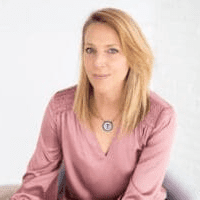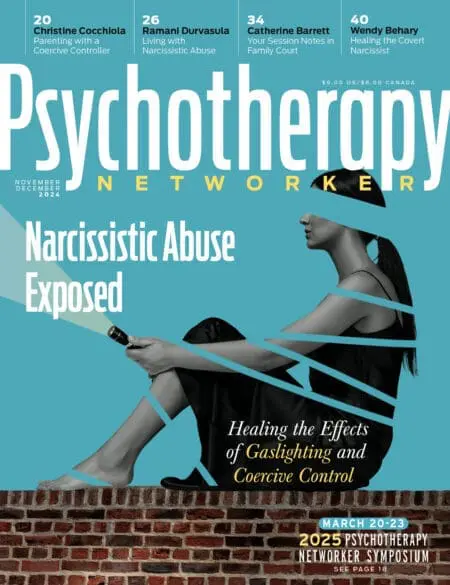So many of our clients come to therapy for anxiety treatment. But the term anxiety itself tends to be overgeneralized, and there’s no one model to treat all the nuances and permutations. What if we could help clients untangle their symptoms, coping strategies, and defenses, so they can get a clear picture of what lies underneath their anxiety—and what if that helped us get a clear picture of how to target our inventions?
Over many years of working with anxious clients, I’ve been struck by three common ways anxiety shows up in our lives, regardless of its origins: catastrophizing, control, and distorted beliefs. Each presentation has a distinct underlying need that drives the anxiety, accompanied by a powerful objection, or way the anxiety fights to preserve itself when challenged. A client can have one, two, or all three presentations, but by teasing them out, we can help effectively address the objections and underlying need to best explore the dynamics at play. An important component is that each also has its own interventions that target the underlying need so as to address the anxiety at its root, not just the symptoms of it.
Catastrophizing
Emily sat in my office spinning in indecision to the point of paralysis about applying to medical school. Since high school, she’d dreamt of becoming a doctor and specializing in pediatric surgery. She was scheduled to take the medical school entrance exam in two months and was avoiding studying while in a near constant state of anxiety. Her body appeared tense, and when she spoke, she spiraled from one concern to another with a look of despair on her face. “What if I don’t get a good score? Or let’s say I get a decent score, what if I apply and don’t get in anywhere? But even if I do get in somewhere, how will I pay for it? What if I can’t handle the workload? I’ll have wasted all that money with nothing to show for it.”
I could feel Emily’s tension and worry. I was aware of how little space there was in between each of her fears for me to respond, no doubt similar to how little space she experienced for herself in the midst of them.
This is catastrophizing, one of the three common ways anxiety manifests in clients. It involves imagining worst-case scenarios of future outcomes and responding to them as though they’re either happening now or are inevitable. Catastrophizing almost always begins with the words what if, and everything that follows is a story. This pattern stems from our discomfort with uncertainty, which the human brain instinctively interprets as a threat. By conjuring up all possible negative outcomes, the mind convinces itself it’s being helpful and protective. Even when therapists try to be helpful by challenging or reassuring clients who are catastrophizing, they’ll usually hear the objection: “But it could happen!” By treating every possible outcome as worthy of attention and worry clients remain tethered to their anxiety, and challenging these fears likely won’t get far.
“That’s a lot to be worried about. No wonder you’re having a hard time studying when you’re so fearful about the outcome,” I said to Emily.
“I know a lot of this is irrational, but I don’t know how to stop,” she replied.
“What do you think these fears are trying to protect you from? How might they be trying to help you?” I asked. With this redirection, not challenging her fears, but seeking to understand them, Emily settled a bit and connected with how meaningful it felt for her to apply to medical school, and how devastating it would be if she failed. With this insight, I asked, “Can you make space for your fear, and see it as a reflection of how much you care about medical school?”
After a few moments, she announced that she noticed a feeling of relief, a sense of calm.
“Good,” I smiled. “Now that you’re feeling more settled, can you tell me what you know to be true about your skills and abilities? Just the facts, no stories.”
Emily easily identified her history of success in school and her resilience in the face of past failures. Her between-session homework was to acknowledge her catastrophizing, to mindfully observe it without attaching to what-if thoughts and worst-case-scenario stories, and then to focus on what she knew to be true. She began to dialogue with the fearful part of her, developing the ability to reassure it rather than trying to force it to go away. Focusing on the facts, not the stories, enabled her to return to studying, apply to schools, make her acceptance choice from many options, and navigate medical school.
Control
Lynn was successful, capable, and chronically stressed. She experienced life as a never-ending to-do list, with little time for relaxation or pleasure. She argued for her inability to rest, noting everything that needed to be done, all of which would only compound if she left a chore unfinished. She had a supportive husband, yet she struggled to let go, routinely finding fault with his way of doing things and thus maintaining the burden on herself. Lynn’s mother had died when she was in high school, and her father—lost in his own grief—had been an absent parent. She acknowledged that her over functioning tendencies were an attempt to cope with the profound sense of helplessness she’d felt then.
Although Lynn was often rewarded for her tendency to run herself into the ground—she was considered successful at everything she did—it left her stuck in a cycle of anxiety and overwhelm. Her sense of wellbeing became dependent on external factors rather than her internal capacity to cope. Attempts to help Lynn let go, do less, and rest at “good enough” were met with an insistence that everything would fall apart without her attention. This is a common objection when anxiety is manifesting as control. “My anxious behaviors are the reason I’m successful, so they’re absolutely necessary!”
This anxiety presentation involves an imbalance: overfocusing on what’s beyond our control—such as what others think, feel, or do—while neglecting the things within our control, like our thoughts, actions, feelings, and responses to our emotions and circumstances. This imbalance can leave us feeling helpless, powerless, or even victimized. A crucial question to ask clients struggling with this anxiety presentation is: “What’s truly within my control, and how do I want to respond?”
At its core, control is an attempt to compensate for an innate, default belief that “I’m not okay” or “It will not be okay.” The unmet need here is for safety and security. Some clients seek to create safety by exerting control over their environment. They’re driven by an unconscious belief that if they know what to expect, or if things happen the way they want them to or think they should, then they’ll be okay. It often looks like inflexibility, rigid expectations of self and others, excessive preparation and research, perfectionism, and taking on too much responsibility for others. Others will anticipate everything that might go wrong and make a plan for what to do should those problems arise. The underlying belief here is, If I prepare for everything that might go wrong, then I’ll be okay when it does.
In my work with Lynn, we focused on honoring her coping response of seeking control following her mother’s death. Slowly, she was able to see all the ways this response was now a source of stress and overwhelm, reinforcing her feelings of isolation. Her controlling, micromanaging, perfectionistic behaviors blocked others from helping and supporting her. What was once protective was now harmful.
I invited Lynn to share previously unprocessed feelings of grief about her mother—something she’d “never had time for.” We also worked to shift her sense of well-being from relying on external factors to internal ones. To let go of her anxiety and the behaviors associated with it, she needed to recognize that her internal strengths, skills, and knowledge were the true reason she was successful. This required creating experiments—opportunities for Lynn to practice letting go, doing less, resting, playing, and relaxing. We began with small, low-stakes practices to build tolerance and resource her for the inevitable discomfort that came with doing things differently. As her capacity to tolerate discomfort grew, so too did her sense of ease, calm, and enjoyment of life.
Distorted Beliefs
Helen was referred to me by her long-term therapist, who was stuck in her efforts to help her disengage from her deeply entrenched anxiety. Whenever her therapist tried to challenge Helen’s distorted thinking, she argued back with two words: “yes, but…” Distorted beliefs fueling anxiety often boil down to core negative self-perceptions—such as I’m unlovable, I’m a failure, or I’m a fraud—which drive compensating behaviors.
When a therapist challenges a client with anxiety wrapped up in distorted beliefs by giving them a compliment or offering objective feedback, a “yes, but…” statement will usually follow: “Yes, but you’re just saying that because you’re my therapist,” or anything that deflects, invalidates, or minimizes the positive statement. This objection shows up outside of therapy, too, when compliments or positive feedback is offered. The more attached a client is to the distorted belief, the stronger and more sophisticated the objection will be, thereby preserving the distortion. I liken distorted beliefs to viewing oneself through a funhouse mirror and mistaking the warped reflection for reality. These beliefs often originate in childhood, as the mind of a child attempts to make sense of and cope with early challenging experiences.
In one session, Helen shared an anxiety-filled scenario: her parents visiting her apartment before they all went out to dinner. She obsessed over hosting, stressing about what snacks to serve, and even bought new furniture to create the “perfect” home. She wondered “What would a normal person serve for a snack? What would a good hostess do?” When I asked Helen about her experience with her parents, she said they’d always been kind and accepting, and that her anxieties had nothing to do with them. Rather, her attempts to improve her home stemmed from a long-held belief that she was “broken and incapable.” Hosting perfectly was her attempt to feel whole and worthy.
In the final moments of the session, Helen said, “I’m worried that I’m not broken enough for you to be seeing me. Your time is valuable.”
Disarmed by her statement, I said, “Your time is as valuable as mine and I can hear how much anxiety affects your daily life. I’m glad you’re here to work on it.” But reflecting on this later, I felt I’d responded too quickly and overlooked an opportunity. So in the next session, I asked how she’d felt after sharing her worry about wasting my time.
“Actually,” she said. “I beat myself up for saying that this whole week. I’ve been worried that you thought I’d said something stupid.”
I highlighted how her distorted belief about being broken had turned my affirming response into another judgment against herself. Her anxiety ensured she always felt “not good enough”—too flawed to host her parents but not flawed enough for therapy.
Helen, arguing for her distorted beliefs, replied, “But even if you thought it was stupid, you wouldn’t tell me.”
“If there was something about what you said that I thought we should look at, I’d find a way to do that,” I told her. “And I’m never going to say something I don’t mean. Can I share with you what I did think?” When she nodded, I said, “It was incredibly helpful you shared that worry with me. I was impressed you could say what you were thinking and feeling in the moment. That’s doing therapy at a master level.”
Helen sat in silence, looking uncomfortable. After a pause, she admitted, “You just took away my ability to discount what you said. I want to accept your feedback, but it’s hard to.”
“Let yourself feel the discomfort,” I suggested. “And see if you can make even just a little space for my view of you. It’s okay to feel uncomfortable as you consider this new possibility.”
Healing anxiety from distorted beliefs involves identifying core falsehoods, addressing the behaviors that maintain them, and helping clients internalize more accurate truths. It also requires clients to practice new behaviors aligned with reality while building resilience for the discomfort of change. Self-compassion—rooted in understanding the origins of maladaptive beliefs and accepting one’s human imperfections—is especially powerful in countering the self-loathing distorted beliefs often carry.
***
It’s not easy to figure out what to focus on as we struggle to help anxious clients. We can all get caught up in their “anxiety whirlwind” of dysregulation, distorted thoughts, and defensiveness. Understanding some of the most common ways anxiety can look in therapy, the underlying needs fueling it, and the objections that accompany it can provide us with guideposts to intervene strategically and support better outcomes for our clients.
Noelle McWard Aquino
Noelle McWard Aquino, LCSW is a speaker, trainer and clinician practicing in Chicago. She’s the author of Anxiety Unpacked: Discover Your Type and Recover your Peace.













